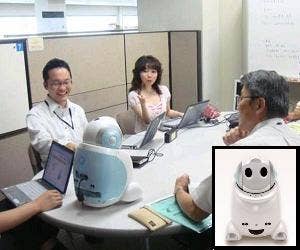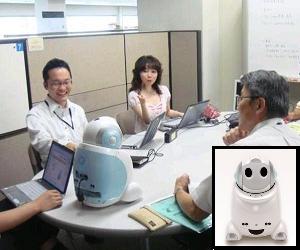PaPeRo Is the TeleRobot Cute Enough To Kill Your Landline and Take Its Place

Share
When you're a super cute blushing robot, humans will let you get away with murder. Especially if the thing you're killing is dying a slow death anyway. NEC in Japan developed its Partner-type Personal Robot, or PaPeRo, as a communications platform for research into human-machine interactions. Now, they're testing the lovable bot as a teleconferencing tool. In a series of experiments in office-like settings, NEC found that users preferred the diminutive device to typical conference phones. Able to recognize faces, respond to touch and speech, swivel its head, and wheel around, PaPeRo could make a very cool table-top telerobot. I certainly wouldn't mind it replacing the landline at my office. Unfortunately, this case study probably won't lead to any commercially available device in the near future as NEC is still in research. Still, I'm excited by PaPeRo showing off its telepresence talent because it's another sign that the race to create personal robots is heating up.
NEC created PaPeRo to help them "investigate the relationships between people and robots." Essentially that means they created it to be as adorable as it is helpful - it actually blushes when it gets loved. The subject of many case studies and demonstrations over the past half dozen or so years, PaPeRo has seen a variety of possible applications. It's helped take care of children, greeted people to museums, and was recently tested in nursing homes as a combination companion/news delivery system. It seems to excel in interactions with humans because its talents are specifically geared towards the ways we communicate - facial expressions, eye contact, audio, and touch. You can get a taste of these capabilities in the video below, taken during one of its many conference appearances.
Most of the qualifications for good human-robot interactions apply to humans wanting to speak to other humans through a robot. Capable of being remotely controlled via an online interface, PaPeRo can perform the same movements (swiveling its head to look at a speaker) as you might if you were in the room yourself. Its big camera eyes give you a good sense of what's happening around the room, while its responsive face can convey simple emotions to your colleagues.
I would think that most telerobots should actually have a display screen that shows the speaker's face. Why use an elaborate robotic facial expression system when a small LCD monitor can do the same at a fraction of the cost? Optimally, one would hope that we could combine robot gestures and human faces to get the best out of both worlds, as we've seen before with MIT's MeBot. Keep the blushes, the swiveling head and the little dancing body, add in the user's real face, and you'll have a system that humans can relate to on many levels. At least, that's what I would do. Several other developers have gone with the robot only (no screen) approach to telepresence, and it may be there are applications where this will be preferable. Personally I think cold robot faces speaking with the voices of my friends would be creepy, but that might just be my cultural context. I know Japan has a different relationship with its bots.
Be Part of the Future
Sign up to receive top stories about groundbreaking technologies and visionary thinkers from SingularityHub.


If you're waiting for PaPeRo to brighten your home or office phone conversations, don't hold your breath. While NEC rents out PaPeRo units on a limited basis, there's little indication that the bot will actually reach market anytime soon. That's okay. All we really need is a plurality of robot companies investing in the personal robot paradigm, and we already have that. From complex and highly capable human-scale machines like Willow Garage's PR2 to smaller fun-orientated 'pets' like Pleo, the industry clearly understands the importance of bringing a robot to market that humans can both rely upon and enjoy as a companion. With all of this background experience, it will hopefully only be a small matter of time before someone can cobble together enough working systems to create a personal robot that every one will want and be able to buy. I'm guessing that one of the killer applications for said mythical future personal robot will be telepresence. Take a good look at PaPeRo sitting on that conference table. The first successful personal robot of the future is probably going to be very similar, and doing much of the same work.
How will we celebrate when that bot finally arrives? I'll probably spend the day blogging about it, but I'm guessing Japan will have a slightly less reserved reaction. I'll leave you with a little PaPeRo video to demonstrate what I mean. It's the perfect combination of cute and WTF. Don't miss PaPeRo 'interacting' with the elderly around 2:00.
[image credits: NEC via Robonable]
[video credits: Hardwarezone.com, NEConlineTV]
[sources: Robonable, NEC (Jp and En)]
Related Articles

These Robots Are the Size of Single Cells and Cost Just a Penny Apiece

In Wild Experiment, Surgeon Uses Robot to Remove Blood Clot in Brain 4,000 Miles Away

A Squishy New Robotic ‘Eye’ Automatically Focuses Like Our Own
What we’re reading
